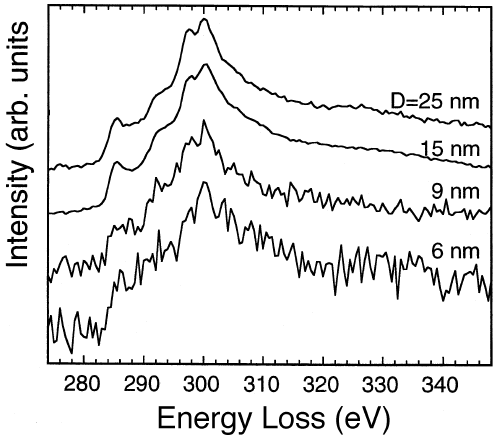=================================================================================
The experimental signal-to-noise-ratio for the EEL spectra of nanostructures is normally poor mainly because of two reasons:
i) The extremely small number of atoms of an interesting element present in these nanostructures,
ii) Remarkably weak electron beam is normally employed to avoid the irradiation damage.
Figure 2783 shows the EEL spectra of potassium-doped carbon nanotube bundles with different nanotube diameters ranged from 6 to 25 nm. Due to the much smaller number of carbon atoms in the smaller nanotubes, the signal-to-noise-ratios of the spectra of smaller nanotubes is worse under the same microscope conductions or even though with longer exposure time. Especially, the spectrum of the nanotubes in diameter of 6 nm is extremely noisy.

Figure 2783. The EEL spectra of potassium-doped carbon nanotube bundles wtih different nanotube diameters ranged from 6 to 25 nm. Adapted from [1]
If the noise in an EELS profile is large , a practical procedure to study the profile, e.g. SSD, is:
i) Use Savitzky-Golay filter to smoothen the raw spectra.
ii) Compute the first derivative.
iii) Find the useful information, for instance, related to electronic structures of the materials.
[1] S. Suzuki, C. Bower, O. Zhou, In-situ TEM and EELS studies of alkali–metal intercalation with single-walled carbon nanotubes, Chemical Physics Letters 285 1998. 230–234.
|
